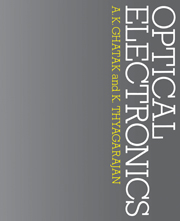Book contents
- Frontmatter
- Contents
- Preface
- 1 Maxwell's equations and propagation of electromagnetic waves
- 2 Reflection and refraction of electromagnetic waves
- 3 Wave propagation in anisotropic media
- 4 Fraunhofer diffraction
- 5 Fresnel diffraction
- 6 Spatial frequency filtering
- 7 Holography
- 8 Lasers: I
- 9 Lasers: II
- 10 Some laser systems
- 11 Electromagnetic analysis of the simplest optical waveguide
- 12 Leaky modes in optical waveguides
- 13 Optical fibre waveguides
- 14 Integrated optics
- 15 The electrooptic effect
- 16 The strain optic tensor
- 17 Acoustooptlc effect: Raman–Nath diffraction
- 18 Acoustooptic effect: Bragg diffraction
- 19 Acoustooptic devices
- 20 Nonlinear optics
- Appendices
- References and suggested reading
- Index
7 - Holography
Published online by Cambridge University Press: 05 June 2012
- Frontmatter
- Contents
- Preface
- 1 Maxwell's equations and propagation of electromagnetic waves
- 2 Reflection and refraction of electromagnetic waves
- 3 Wave propagation in anisotropic media
- 4 Fraunhofer diffraction
- 5 Fresnel diffraction
- 6 Spatial frequency filtering
- 7 Holography
- 8 Lasers: I
- 9 Lasers: II
- 10 Some laser systems
- 11 Electromagnetic analysis of the simplest optical waveguide
- 12 Leaky modes in optical waveguides
- 13 Optical fibre waveguides
- 14 Integrated optics
- 15 The electrooptic effect
- 16 The strain optic tensor
- 17 Acoustooptlc effect: Raman–Nath diffraction
- 18 Acoustooptic effect: Bragg diffraction
- 19 Acoustooptic devices
- 20 Nonlinear optics
- Appendices
- References and suggested reading
- Index
Summary
Introduction
A photograph represents a two-dimensional recording of a three-dimensional scene. What is recorded is the intensity distribution that prevailed at the plane of the photograph when it was exposed. The light sensitive medium is sensitive only to the intensity variations and hence while recording a photograph, the phase distribution which prevailed at the plane of the photograph is lost. Since only the intensity pattern has been recorded, the three-dimensional character (e.g., parallax) of the object scene is lost. Thus one cannot change the perspective of the image in the photograph by viewing it from a different angle and one cannot refocus any unfocussed part of the image in the photograph. Holography is a method evolved by Gabor in 1948, in which one not only records the amplitude but also the phase of the light wave. Because of this the image produced by the technique of holography has a true three-dimensional form. Thus, as with the object, one can change one's position and view a different perspective of the image and one can focus at different distances. The capability to produce images as true as the object itself is what is responsible for the wide popularity gained by holography.
The basic technique in holography is the following: in the recording of the hologram, one superimposes on the object wave another wave called the reference wave (which is usually a plane wave) and the photographic plate is made to record the resulting interference pattern (see Fig. 7.1(a)).
- Type
- Chapter
- Information
- Optical Electronics , pp. 181 - 200Publisher: Cambridge University PressPrint publication year: 1989



